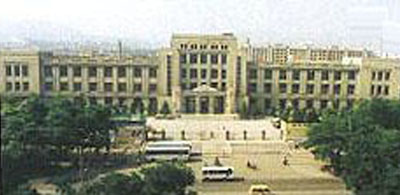 |
Located at Qilihe of Lanzhou City, the Gansu Provincial Museum is a local comprehensive museum. First built in 1956, the Museum's predecessor is the Science Education Hall of Gansu built in 1939. After several name changes, the Museum got its present name in 1956 and was opened to the public in 1958. The Museum covers a construction area of 180,000 square meters.
The Museum boasts 75,000 cultural relics, ranging from natural specimens to historical, revolutionary and national heritages, of which more than 110 pieces are of the first class, including Gansu color-painted pottery, and bamboo slips on medication of the Han era, etc. The most famous piece in the collection of Han Dynasty (206BC-220AD) bronzes is the Galloping Horse of Wuwei that is accompanied by an impressive array of chariots and carriages.
With 7,500 square meters of exhibition space, the Museum mainly features five exhibition halls, namely, the Hall of Gansu Historical Relics, the Hall of Gansu Natural Resources, the Hall of Jiayuguan Murals of Wei and Jin Period, the Hall of the Yellow River Ancient Elephants, and the Hall of Red Army's Long March via Gansu.
The Hall of Historical Relics exhibits about 1,500 items of unearthed relics, mainly including painted pottery bowls, vessels and agricultural tools, and excavations from the Silk Road of the Han (206BC-220AD) and Tang (618-907) periods. The unearthed pottery objects bear the patterns of birds, frogs, flowers or leaves. Among them, pottery vessels of Majiayao Culture excavated from the region of the Yellow River Valley are the best. Geometric motifs like parallel lines, circles, crosses, and spirals (volutes) were used.
The Hall of Natural Resources exhibits about 1,380 items of real objects as well as models, introducing knowledge on Gansu's population, nationality, transportation, climate, animals and plants resources, etc.
The Hall of Jiayuguan Murals of Wei and Jin Period (220-420) displays over 60 murals on the tomb bricks mainly depicting the daily life of the aristocrats, laboring scenes of the common people, and imperial life. The colorings are well-preserved and still very vivid.
The Hall of the Yellow River Ancient Elephants exhibits a 4-meter-tall and 8-meter-long fossil of the Yellow River Xiphodon mammoth, which is the largest and best-preserved remains of its kind in the world.
The last hall contains revolutionary relics of the Long March, including pictures, documents, and real objects, etc.
Publications of the Museum includeWuwei Han Bamboo Slips, andGansu Color-painted Pottery, etc.